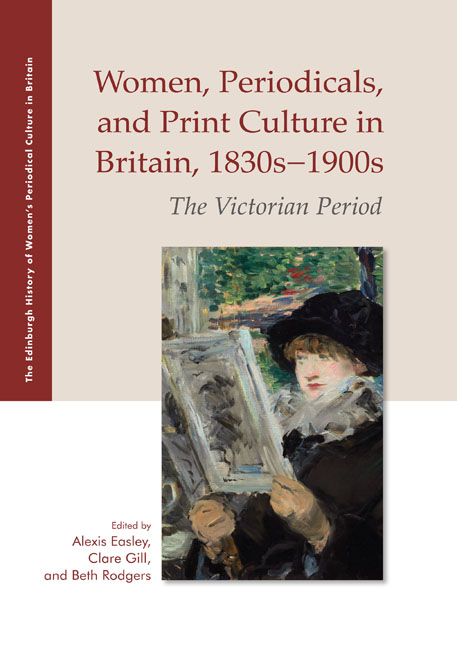Book contents
- Frontmatter
- Contents
- List of Illustrations
- Acknowledgments
- Introduction: Women, Periodicals, and Print Culture in the Victorian Period
- Part I (Re)Imagining Domestic Life
- Part II Constructing Modern Girls and Young Women
- Part III Women and Visual Culture
- Women and Visual Culture: Introduction
- 13 Vicarious Pleasures: Photography, Modernity, and Mid-Victorian Domestic Journalism
- 14 Beauty Advertising and Advice in the Queen and Woman
- 15 Women of the World: The Lady's Pictorial and Its Sister Papers
- 16 Rewriting Fairyland: Isabella Bird and the Spectacle of Nineteenth-Century Japan
- 17 Victorian Women Wood Engravers: The Case of Clemence Housman
- Part IV Making Space for Women
- Part V Constructing Women Readers and Writers
- Part VI Intervening in Political Debates
- Notes on Contributors
- Index
- Plate section
15 - Women of the World: The Lady's Pictorial and Its Sister Papers
from Part III - Women and Visual Culture
Published online by Cambridge University Press: 25 October 2019
- Frontmatter
- Contents
- List of Illustrations
- Acknowledgments
- Introduction: Women, Periodicals, and Print Culture in the Victorian Period
- Part I (Re)Imagining Domestic Life
- Part II Constructing Modern Girls and Young Women
- Part III Women and Visual Culture
- Women and Visual Culture: Introduction
- 13 Vicarious Pleasures: Photography, Modernity, and Mid-Victorian Domestic Journalism
- 14 Beauty Advertising and Advice in the Queen and Woman
- 15 Women of the World: The Lady's Pictorial and Its Sister Papers
- 16 Rewriting Fairyland: Isabella Bird and the Spectacle of Nineteenth-Century Japan
- 17 Victorian Women Wood Engravers: The Case of Clemence Housman
- Part IV Making Space for Women
- Part V Constructing Women Readers and Writers
- Part VI Intervening in Political Debates
- Notes on Contributors
- Index
- Plate section
Summary
THE LADY'S PICTORIAL was a prominent illustrated weekly in the 1880s and 1890s. This essay situates the magazine in relation to the other illustrated sixpenny weeklies controlled by Ingram Brothers, a major early press conglomerate. By the mid-1890s, the Ingram weeklies consisted of the Illustrated London News, the Sketch, the Lady's Pictorial, and the Illustrated Sporting and Dramatic News. All of these periodicals proclaimed their use of imagery through their titles, all posited a middleclass readership, and all were innovators in new imaging technologies and techniques. They shared writers, illustrators, editorial content, and advertising, yet they were arranged to cover very distinct spheres of the contemporary scene, attracting readers and advertisers on this basis. In this study, I look at the different ways in which these texts mapped women's space as central or peripheral, defining what kinds of gendered knowledge it was possible to produce in the 1890s.
I will outline the position of women's writing and imagery in the sister papers of the Lady's Pictorial and then look in more depth at the magazine itself. Beginning in 1880, the Lady's Pictorial constructed a distinctive and enlarged female sphere, encompassing fashion, art, literature, careers, the home, and good works. Its launch was particularly well timed. The last two decades of the nineteenth century marked a turning point in gender roles, as legal, economic, medical, and social changes affected the status of women and men. Women moved into the workforce in large numbers: between 1881 and 1911, there was 161 per cent increase in the number of women workers in middle-class occupations (Holcome 1973: 76).
At the same time, there was a related expansion of the fashion trade, with the latest styles diffused in the editorial and advertising sections of women's illustrated magazines and displayed and sold in department stores (Fawcett 2004: 145–57; Rappaport 2000: 184–7). All of these phenomena of mobility and circulation were linked. As women moved outside the home to engage in work, shopping, theatre-going, or social engagements, knowing what to wear became increasingly important. As the writer and artist Evelyn March-Phillips noted, ‘Appearance is more constantly dwelt upon and its influence is more widely recognized. Even those who excel in other ways, cannot neglect cultivating the art of dressing well.
- Type
- Chapter
- Information
- Women, Periodicals and Print Culture in Britain, 1830s–1900sThe Victorian Period, pp. 232 - 255Publisher: Edinburgh University PressPrint publication year: 2019



